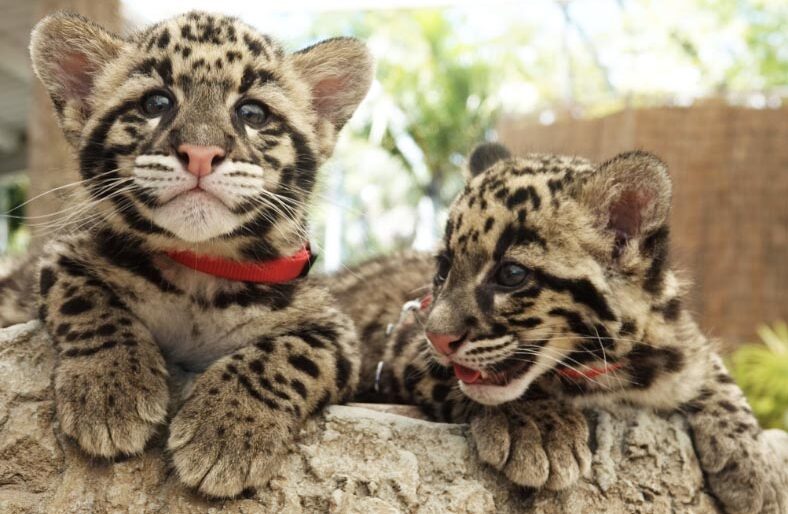
Discover the Wild World of Clouded Leopards – From Scissor Teeth to Tree-Dwelling Talents
Clouded leopards are one of the world’s most fascinating and enigmatic wild cat species. These elusive creatures are found in the dense forests of Southeast Asia–including countries like Nepal, Bhutan, India, Bangladesh, Myanmar, Thailand, Laos, Vietnam, and southern China.
They are renowned for their distinctive markings, exceptional hunting skills, and flexible ankles that allow them to climb down trees headfirst. Despite their striking appearance and impressive abilities, much about the clouded leopard remains shrouded in mystery, and their exact population size and distribution are difficult to determine.
In this regard, recent research has shed light on some fascinating aspects of their biology and behavior, such as their unique teeth, adapted for slicing through tough materials, and their vocalizations, which vary depending on the situation.
Here are some interesting facts about clouded leopards:
- Clouded leopards are named for their distinctive cloud-like markings on their fur.
- They are the smallest of the big cats, weighing between 11 and 23 kg (24 and 50 lb).
- They have exceptionally long canine teeth, which they use to capture prey.
- Unlike other big cats, clouded leopards have flexible ankles that can rotate backward, allowing them to climb down trees headfirst.
- They are known for their exceptional hunting skills and can take down prey much larger than themselves.
- Clouded leopards are among the most elusive and mysterious big cats; much of their behavior and ecology remain unknown.
- The International Union for Conservation of Nature (IUCN) lists them as vulnerable species due to habitat loss, hunting, and illegal wildlife trade.
Do you want to help in conservation efforts for these amazing animals? WWF offers an adopt a clouded leopard initiative where you can also gift an adoption to someone. Makes for great birthday and holiday gifts.
These cats are most commonly found in areas with rugged terrain and dense vegetation and are known for their ability to climb trees and navigate through forest canopies.
However, their exact distribution and population size are difficult to determine due to their elusive nature and the remote and inaccessible areas they inhabit.
The exact population of clouded leopards worldwide is unknown, but they are considered vulnerable species by the International Union for Conservation of Nature (IUCN). The IUCN estimates that fewer than 10,000 mature individuals may be left in the wild.
The population of clouded leopards has declined in recent decades due to habitat loss, hunting, and illegal wildlife trade. Conservation efforts are underway to protect their remaining habitat and prevent further decline in their population.
These efforts include initiatives to reduce hunting and poaching, promote sustainable land use, and improve law enforcement to combat illegal trade in their body parts.
Did you know?
Clouded leopards have the largest canine teeth relative to the body size of any wild cat species. Their canines can be as long as 4 centimeters (1.5 inches), which is proportionally longer than the canines of any other wild cat.
These long teeth help capture prey such as birds, rodents, and other small mammals. Interestingly, clouded leopards have unique teeth among cats. They have two teeth on each side of their upper jaw that are modified to function like scissors, allowing them to slice through tough materials like tendons and feathers.
This adaptation helps them consume their prey more efficiently, using all parts of their meal.
A little history:
Clouded leopards are shrouded in mystery, and their exact origins and evolution need to be better understood. Fossil records suggest that the ancestors of modern clouded leopards may have existed as far back as 4 million years ago. But, little is known about their early history, and their relationship to other wild cat species is still debated among scientists.
Clouded leopards have been known to humans for centuries and have played a role in the mythology and folklore of many cultures in Southeast Asia. They were often seen as powerful and mystical creatures and were sometimes associated with spiritual beliefs or used in traditional medicine.
In recent times, clouded leopards have faced several threats to their survival. Habitat loss, hunting, and illegal wildlife trade have all affected their populations. Conservation efforts have been underway since the 1980s to protect these animals.

They include initiatives to promote sustainable land use, reduce hunting and poaching, and improve law enforcement to combat illegal trade in their body parts.
Despite these efforts, clouded leopards remain vulnerable, and much work remains to ensure their long-term survival. Continued research and conservation efforts will be necessary to understand their biology and behavior better, protect their remaining habitat, and prevent further decline in their populations.



